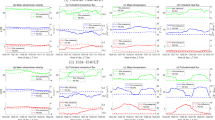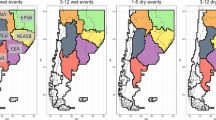Abstract
This study applies acoustic sounding to observe coherent structures in the roughness sublayer (RSL) above tall vegetated surfaces. Data were collected on 22 days during two separate field experiments in summer 2003. A quality control scheme was developed to ensure high data quality of the collected time series. The data analysis was done using both discrete and continuous wavelet transform. The flow in the RSL was found to be a superposition of dynamic Kelvin–Helmholtz instabilities and convective mixing. The characteristic time scales for coherent structures resulting from the dynamic instabilities were observed to be approximately 20–30 s while thermal eddies have much larger time scales of 190–210 s. The degree of vertical coherency in the RSL increases with the flow evolving from neutral to near-convective conditions. This increase in the degree of organisation is attributed to the evolution of attached thermal eddies. The coherent structures resulting from instabilities were found to be present throughout the RSL but do not contribute to the increased vertical coherency. An alternative conceptual approach for the definition of the RSL is proposed, which yields its maximum vertical extent to five times the canopy height.
Similar content being viewed by others
References
Akima, H.: 1970, ‘A New Method of Interpolation and Smooth Curve Fitting Based on Local Procedures’, J. Assc. Comp. Mach. 17, 589–602.
Aubrun S., Koppmann R., Leitl B., Moellmann-Coers M., Schaub A. (2005). ‘Physical Modelling of an Inhomogeneous Finite Forest Area in a Wind Tunnel - Comparison with Field Data and Lagrangian Dispersion Calculations’. Agric. For. Meteorol. 129, 121–135
Bergström H., Högström U. (1989). ‘Turbulent Exchange above a Pine Forest. II. Organized Structures’. Boundary-Layer Meteorol. 49, 231–263
Brunet Y., Irvine M. (2000). ‘The Control of Coherent Eddies in Vegetation Canopies: Streamwise Structure Spacing, Canopy Shear Scale and Atmospheric Stability’. Boundary-Layer Meteorol. 94, 139–163
Chen J., Hu F. (2003). ‘Coherent Structures Detected in Atmospheric Boundary-Layer Turbulence Using Wavelet transforms at Huaihe River Basin, China’. Boundary-Layer Meteorol. 107, 429–444
Collineau S., Brunet Y. (1993a). ‘Detection of Turbulent Coherent Motions in a Forest Canopy. Part I: Wavelet Analysis’. Boundary-Layer Meteorol. 65, 357–379
Collineau S., Brunet Y. (1993b). ‘Detection of Turbulent Coherent Motions in a Forest Canopy Part II: Time-Scales and Conditional Averages’. Boundary-Layer Meteorol. 66, 49–73
Coulter R., Wesely M. (1980). ‘Estimates of Surface Heat Flux from Sodar and Laser Scintillation Measurements in the Unstable Boundary Layer’. J. Appl. Meteorol. 19, 1209–1222
Crescenti G. (1998). ‘The Degradation of Doppler Sodar Performance Due to Noise: A Review’. Atmos. Environ. 32, 1499–1509
Donoho D.L., Johnstone I.M. (1994). ‘Ideal Spatial Adaptation by Wavelet Shrinkage’. Biometrika 81, 425–455
Finnigan J. (2000). ‘Turbulence in Plant Canopies’. Ann. Rev. Fluid Mech. 32, 519–571
Foken T., Göckede M., Mauder M., Mahrt L., Amiro B., Munger J. (2004). ‘Post-field Data Quality Control’. In: Lee X., Massman W.J., Law B. (eds). Handbook of Micrometeorology: A Guide for Surface Flux Measurements. Kluwer, Dordrecht, pp. 181–208
Gao W., Shaw R.H., Paw U.K.T. (1989). ‘Observation of Organized Structures in Turbulent Flow within and above a Forest Canopy’. Boundary-Layer Meteorol. 47, 349–377
Gerstberger P., Foken T., Kalbitz K. (2004). ‘The Lehstenbach and Steinkreuz Catchments in NE Bavaria, Germany’. In: Matzner E.(eds). Biogeochemistry of Forested Catchments in a Changing Environment. Ecological Studies, No. 172, Vol. 172 Springer, Heidelberg, pp. 15–41
Hall F.J., Edinger J., Neff W. (1975). ‘Convective Plumes in the Planetary Boundary Layer, Investigated with an Acoustic Echo Sounder’. J. Appl. Meteorol. 14, 513–523
Haugen D., Kaimal J.C. (1978). ‘Measuring Temperature Structure Parameters Profiles with an Acoustic Sounder’. J. Appl. Meteorol. 17, 895–899
Holschneider M. (1995). Wavelets, An Analysis Tool. Oxford University Press, New York 423 pp
Katul G., Lai C.-T., Schaefer K., Vidakovic B., Albertson J., Ellsworth D., Oren R. (2001). ‘Multiscale Analysis of Vegetation Surface Fluxes: From Seconds to Years’. Adva. Water Resour. 24, 1119–1132
Katul G., Vidakovic B. (1998). ‘Identification of Low-Demensional Energy Containing/Flux Transporting Eddy Motion in the Atmospheric Surface Layer Using Wavelet Thresholding Methods’. J. Atmos. Sci. 55, 377–389
Koppmann R. (2003). ‘Emission and Chemical Transformation of Biogenic Volatile Organic Compounds (ECHO)’. AFO-2000 Newslett. 5, 7–10
Kumar P., Foufoula-Georgiou E. (1994). ‘Wavelet Analysis in Geophysics: An Introduction’. In: Foufoula-Georgiou E., Kumar P. (eds). Wavelets in Geophysics. Vol. 4 of Wavelet Analysis and its Applications. Academic Press, San Diego, pp. 1–43
Little C. (1969). ‘Acoustic Methods for the Remote Probing of the Lower Atmosphere’, in IEEE, Vol. 53, pp. 571–578.
Lu C., Fitzjarrald D. (1994). ‘Seasonal and Diurnal Variations of Coherent Structures over a Deciduous Forest’. Boundary-Layer Meteorol. 69, 43–69
Miller K., Rochwarger M. (1970). ‘On Estimates of Spectral Moments in the Presence of Colored Noise’, in IEEE Trans. Inf. Theory IT-16, pp. 303–308.
Neff, W.: 1975, ‘Quantitative Evaluation of Acoustic Echoes from the Planetary Boundary Layer’, TR ERL 322-WPL 38, NOAA.
Neff W., Coulter R. (1986). ‘Acoustic Remote Sensing’. In: Lenschow D., (eds). Probing the Atmospheric Boundary Layer. American Meteorological Society, Boston, pp. 201–239
Novak M., Warland J., Orchansky A., Kettler R., Green S. (2000). ‘Wind Tunnel and Field Measurements of Turbulent Flow in Forests. Part I: Uniformly Thinned Stands’. Boundary-Layer Meteorol. 95, 457–495
Paw U.K.T., Brunet Y., Collineau S., Shaw R.H., Maitani T., Qiu J., Hipps L. (1992). ‘Evidence of Turbulent Coherent Structures in and above Agricultural Plant Canopies’. Agric. For. Meteorol. 61, 55–68
Petenko I., Argentini S., Bolignano A., Mastrantonio G., Viola A. (2004). ‘Time and Horizontal Scales of Convective Plumes at Mid-latitudes’. In: Anderson P., Bradley S., von Hunerbein S. (eds). 12th International Symposium on Acoustic Remote Sensing. British Antarctic Survey, Cambridge, UK
Petenko I., Bezverkhnii V. (1999). ‘Temporal Scales of Convective Coherent Structures Derived from Sodar Data’. Meteorol. Atmosph. Phys. 71, 105–116
Poggi D., Porporato A., Ridolfi L., Albertson J.D., Katul G.G. (2004). ‘The Effect of Vegetation Density on Canopy Sub-layer Turbulence’. Boundary-Layer Meteorol. 111, 565–587
Raupach M.R., Finnigan J.J., Brunet Y. (1989). ‘Coherent Eddies in Vegetation Canopies’, in 4th Australasian Conference on Heat and Mass Transfer, Christchurch, New Zealand, pp. 75–90.
Raupach M.R., Finnigan J.J., Brunet Y. (1996). ‘Coherent Eddies and Turbulence in Vegetation Canopies: The Mixing-layer Analogy’. Boundary-Layer Meteorol. 78, 351–382
Spizzichino A. (1974). ‘Discussion of the Operating Conditions of a Doppler Sodar’. J. Geophys. Res. 79, 5585–5591
Taconet O., Weill A. (1982). ‘Vertical Velocity Field in the Convective Bounadry layer as observed with an Acoustic Doppler Sodar’. Boundary-Layer Meteorol. 23, 133–151
Tatarskii V. (1971). The Effects of the Turbulent Atmosphere on Wave Propagation. Moscow, 1967, Israel Program for Scientific Translations, U.S. Dept. of Commerce: Nauka.
Thomas C., Foken T. (2005). ‘Detection of Long-term Coherent Exchange over Spruce Forest Using Wavelet Analysis’. Theor. Appl. Climatol. 80, 91–104
Wesely M. (1976). ‘The Combined Effect of Temperature and Humidity Fluctuations on Refractive Index’. J. Appl. Meteorol. 15, 43–49
Wesson K.H., Katul G.G., Siqueira M. (2003). ‘Quantifying Organization of Atmospheric Turbulent Eddy Motion Using Nonlinear Time Series Analysis’. Boundary-Layer Meteorol. 106, 507–525
Williams A., Hacker J. (1993). ‘Interactions between Coherent Eddies in the Lower Convective Boundary Layer’. Boundary-Layer Meteorol. 64, 55–74
Author information
Authors and Affiliations
Corresponding author
Rights and permissions
About this article
Cite this article
Thomas, C., Mayer, JC., Meixner, F.X. et al. Analysis of Low-Frequency Turbulence Above Tall Vegetation Using a Doppler Sodar. Boundary-Layer Meteorol 119, 563–587 (2006). https://doi.org/10.1007/s10546-005-9038-0
Received:
Published:
Issue Date:
DOI: https://doi.org/10.1007/s10546-005-9038-0




